AFRL marks 20th anniversary of DOD WPAFB STARBASE program
WRIGHT-PATTERSON AIR FORCE BASE, Ohio (AFRL) – The Air Force Research Laboratory, or AFRL, celebrated the 20th anniversary of the Department of Defense STARBASE Wright-Patt program Oct. 4, 2024, at the Wright-Patterson Air Force Base Child Development Center, on Spinning Road near Area B, in Dayton, Ohio.
STARBASE Wright-Patt is a K-12 DOD STEM outreach program managed by the Wright-Patterson Education Outreach Office, primarily targeting fifth-grade students. Wright-Patterson was among the first active-duty bases to launch a STARBASE program.
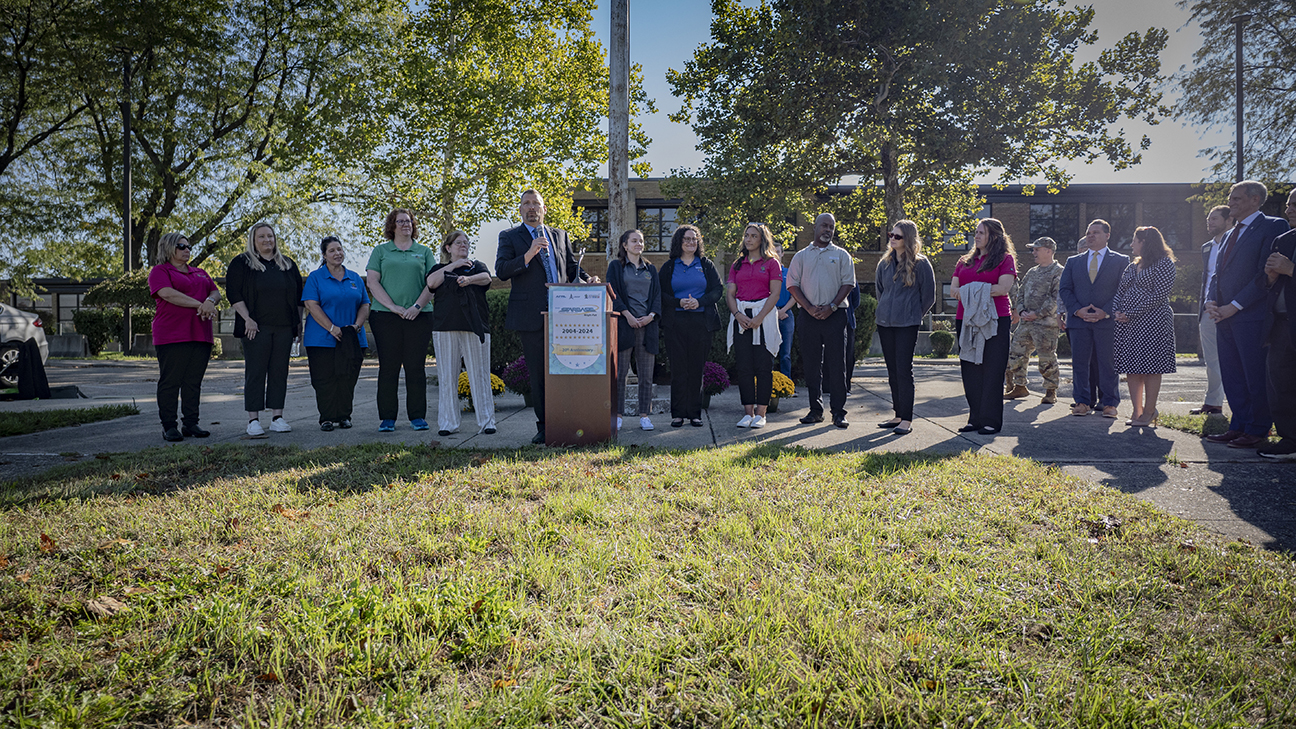
Dan Andrews, STEM division chief at the Air Force Research Laboratory, thanks the leaders, mentors and volunteers from the podium at the 20th anniversary celebration of the a Department of Defense STARBASE Wright-Patt program Oct. 4, 2024, at Child Development Center on Spinning Road in Dayton, Ohio. STARBASE Wright-Patt is a K-12 DOD science, technology, engineering and math outreach program managed by the Wright-Patterson Air Force Base Education Outreach Office that is primarily focused on fifth-grade students. Since 2003, more than 47,000 students have participated in the DOD Wright-Patt STARBASE program. (U.S. Air Force photo / Keith Lewis)
The initiative began 20 years ago when Kathy Schweinfurth, chief, Wright-Patterson Air Force Base Educational Outreach Program, and Dr. Vince Russo with the University of Dayton’s School of Engineering, advocated for a science, technology, engineering and math, or STEM, program that would allow more children in the community to gain exposure to STEM activities, said Dan Andrews, AFRL STEM division chief.

Air Force Research Laboratory Commander Brig. Gen. Jason E. Bartolomei addresses leaders and community members at the 20th anniversary celebration of the Department of Defense STARBASE Wright-Patt program Oct. 4, 2024, at a Child Development Center on Spinning Road in Dayton, Ohio. STARBASE Wright-Patt is a K-12 DOD science, technology, engineering and math outreach program managed by the Wright-Patterson Air Force Base Education Outreach Office and is primarily focused on fifth-grade students. Wright-Patterson Air Force Base was one of the first active-duty bases to launch a STARBASE program. (U.S. Air Force photo / Keith Lewis)
Since 2003, more than 47,000 students have participated in the DOD Wright-Patt STARBASE program.
“STARBASE is a shining example of what we can accomplish when the military, educators and community join forces to invest in our youth,” said AFRL Commander Brig. Gen. Jason E. Bartolomei. “That’s a pretty powerful thing.”
Of the 90 STARBASE locations, Wright-Patterson is the only one in Ohio and one of the first to earn Center of Excellence-Level III status, designating it as a high-performing program in 2022. It is one of six locations to receive that top distinction, according to the proclamation read by Ohio Director of Military and Veteran Relations Tammy Puff and signed by Gov. Mike DeWine and Lt. Gov. John Husted.
“This isn’t just a normal STARBASE,” Bartolomei said. “This is one of the best STARBASEs. That’s a big accomplishment, and my understanding is that the demand is so high that there’s a waiting list to participate. I think it speaks volumes to the success of the program.”
The success of the program is rooted in a strong partnership with the Department of the Air Force, Wright-Patterson Air Force Base, local schools and community organizations, he said.
“We owe a massive debt of gratitude to the educators, the mentors and volunteers who poured their hearts and souls into this program,” Bartolomei added.
The past 20 years have seen significant advancements in STEM-related activities and career fields.
“STARBASE has stood the test of time by adapting to an ever-changing landscape of technology and education, leveling up our programs with cutting-edge tools and techniques from robotics and coding to 3D printing and cyber defense,” Bartolomei said.
STEM fields are reshaping national defense, said Bartolomei, emphasizing their importance to the DAF. The mission of AFRL is to keep Air and Space Forces ahead through cutting-edge science and technology.
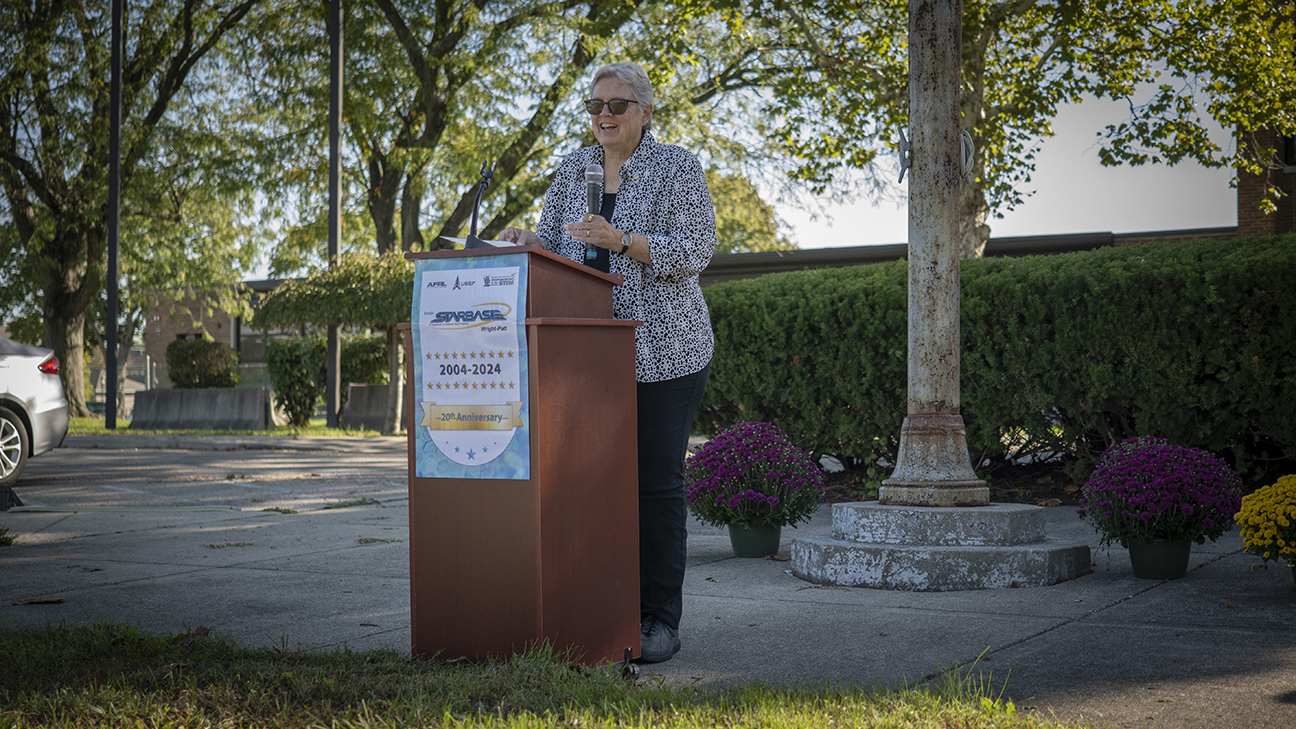
Ohio Director of Military and Veteran Relations Tammy Puff reads a proclamation signed by Gov. Mike DeWine and Lt. Gov. John Husted, as Air Force Research Laboratory leaders and community members celebrate the 20th anniversary of the Department of Defense STARBASE Wright-Patt program Oct. 4, 2024, at a Child Development Center on Spinning Road in Dayton, Ohio. “STARBASE itself is an incredible program. It helps to prepare the coming generations for the workforce, particularly in the growing field of [science, technology, engineering and math] jobs,” Puff said. “The educators here are phenomenal, dedicated and passionate about their work. You watch the commitment, and you know they absolutely love what they’re doing.” (U.S. Air Force photo / Keith Lewis)
“This program teaches our kids to be critical thinkers, problem solvers and team players, skills that apply anywhere their dreams may take them,” Bartolomei added
In addition to the fifth-grade program, STARBASE has expanded over the years to four after-school programs providing advanced STEM opportunities for sixth-grade students, connecting them to technological environments and civilian and military role models within the DOD, according to the proclamation.
Andrews noted three former students in attendance at the event, showcasing the program’s long-term impact: Heidi Kennard, a high-school student, and Christian Collins, a college student, both members of the DAF LEGACY program; and Taylor Tyson, an educator.
“This shows a clear path from elementary school through higher education to career success,” Andrews said. “Investing in K-12 education is critical. We must look beyond immediate needs and plan 10, 20, or even 30 years ahead, just as leaders did 20 years ago when they saw the need for these programs.”
Kennard, currently a senior at Wayne High School in Huber Heights, works summers with the Rapid Development Integration Facility, or RDIF, at Wright-Patterson Air Force Base. Early exposure to STEM education led her to pursue engineering, she said.
While Kennard encouraged other K-12 students to engage with the STARBASE program, if that isn’t an option, there are other ways to explore STEM, such as through the STEM LEGACY Craftsman camps, she said. These STEM camps are available yearly and offer activities for diverse groups.
“That’s what my family did,” Kennard said. “That’s how I got into my job.”
Among other STEM-related skills, Kennard said, LEGACY camps taught her how to code and connected her with a junior apprenticeship at the age of 16. Eventually, those experiences, coupled with her exposure to STARBASE, helped her land her current position working with the Air Force.

Air Force Research Laboratory Commander Brig. Gen. Jason E. Bartolomei, right, shakes hands with Ian Berry, deputy director of the Department of Defense STARBASE Wright-Patt program, during a facility tour at the program’s a 20th anniversary celebration Oct. 4, 2024, at a Child Development Center on Spinning Road in Dayton, Ohio. STARBASE Wright-Patt is a K-12 DOD science, technology, engineering and math outreach program managed by the Wright-Patterson Air Force Base Education Outreach Office that is primarily focused on fifth-grade students. Since 2003, more than 47,000 students have participated in the DOD Wright-Patt STARBASE program. (U.S. Air Force photo / Keith Lewis)
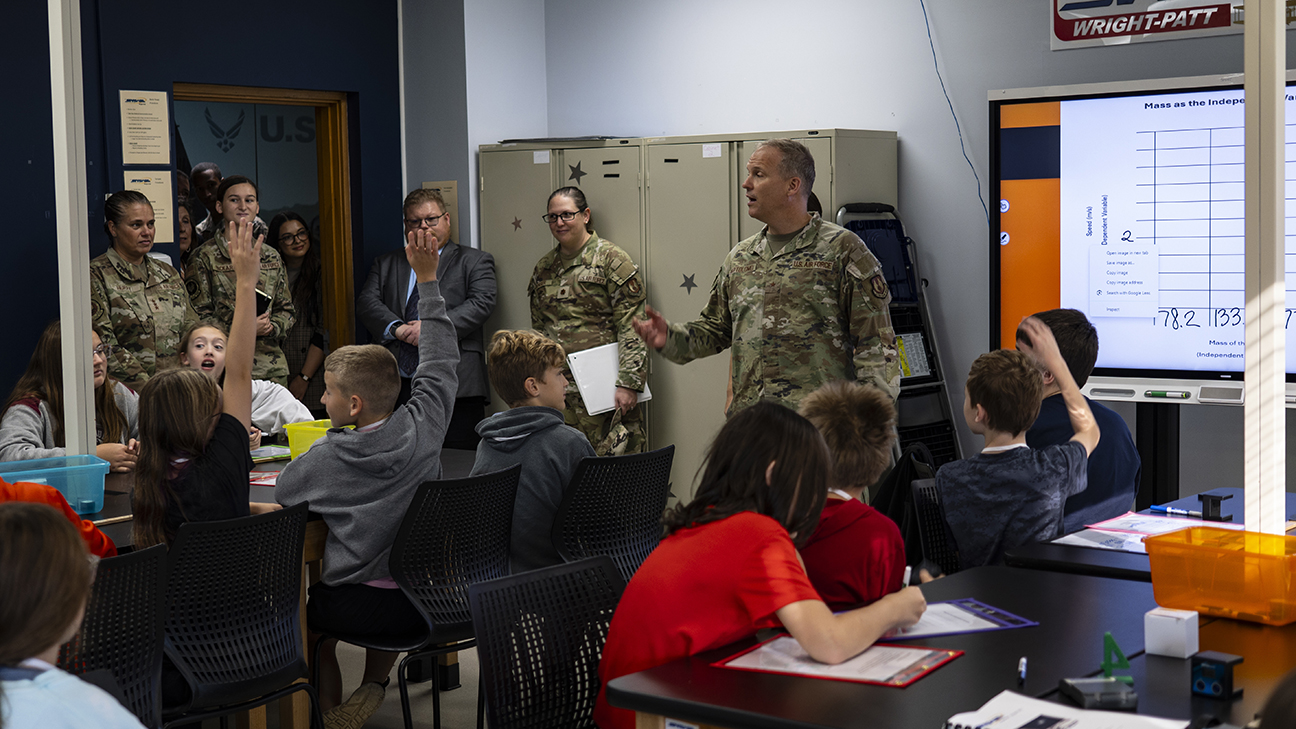
Air Force Research Laboratory Commander Brig. Gen. Jason E. Bartolomei takes questions from a classroom full of students during the 20th anniversary celebration of the Department of Defense STARBASE Wright-Patt program Oct. 4, 2024, at a Child Development Center on Spinning Road in Dayton, Ohio. STARBASE Wright-Patt is a K-12 DOD science, technology, engineering and math outreach program managed by the Wright-Patterson Air Force Base Education Outreach Office that is primarily focused on fifth-grade students. Wright-Patterson Air Force Base was one of the first active-duty bases to launch a STARBASE program. (U.S. Air Force photo / Keith Lewis)

From left: Air Force Research Laboratory Commander Brig. Gen. Jason E. Bartolomei introduces Heidi Kennard, a high school senior at Wayne High School in Huber Heights; Christian Collins, an undergraduate student studying electrical engineering at Wright State University; and Taylor Tyson, an education specialist at the Wright Patterson Air Force Base K-12 Education Outreach Office for AFRL, during the 20th anniversary celebration of the Department of Defense STARBASE Wright-Patt program. The event was held Oct. 4, 2024, at a Child Development Center on Spinning Road in Dayton, Ohio. Each of the former DOD STARBASE Wright-Patt program participants are pursuing a career in science, technology, engineering or math, or STEM. STARBASE Wright-Patt is a K-12 DOD STEM outreach program managed by the Wright-Patterson Air Force Base Education Outreach Office and is primarily focused on fifth-grade students. (U.S. Air Force photo / Keith Lewis)
As part of her job with the RDIF, Kennard has worked with the Air Force Uniform Office to help develop Air and Space Force uniforms. Recently, she visited North Carolina State University to work in their textiles program, which sparked a new STEM-related interest.
“I actually have kind of a unique career aspiration,” Kennard said. “I want to develop spacesuits using materials and textiles engineering, specifically.”
“The LEGACY [program] opened up so many opportunities for me,” she added.
Collins, a DAF LEGACY apprentice and undergraduate student studying electrical engineering at Wright State University, also works part time at the Wright-Patterson Air Force Base Educational Outreach office, helping create lesson plans for STARBASE students.
Collins said STEM education enabled him to narrow down potential fields of study.
“Once I started attending STARBASE, and then the LEGACY program, they taught me more about the STEM fields, and how I can better help people that need it and help our country with the research we are doing,” Collins said.
Tyson, an education specialist at the Wright-Patterson Air Force Base Educational Outreach Office, K-12 outreach for AFRL, said she credits STARBASE with sparking her interest in STEM in fifth grade.
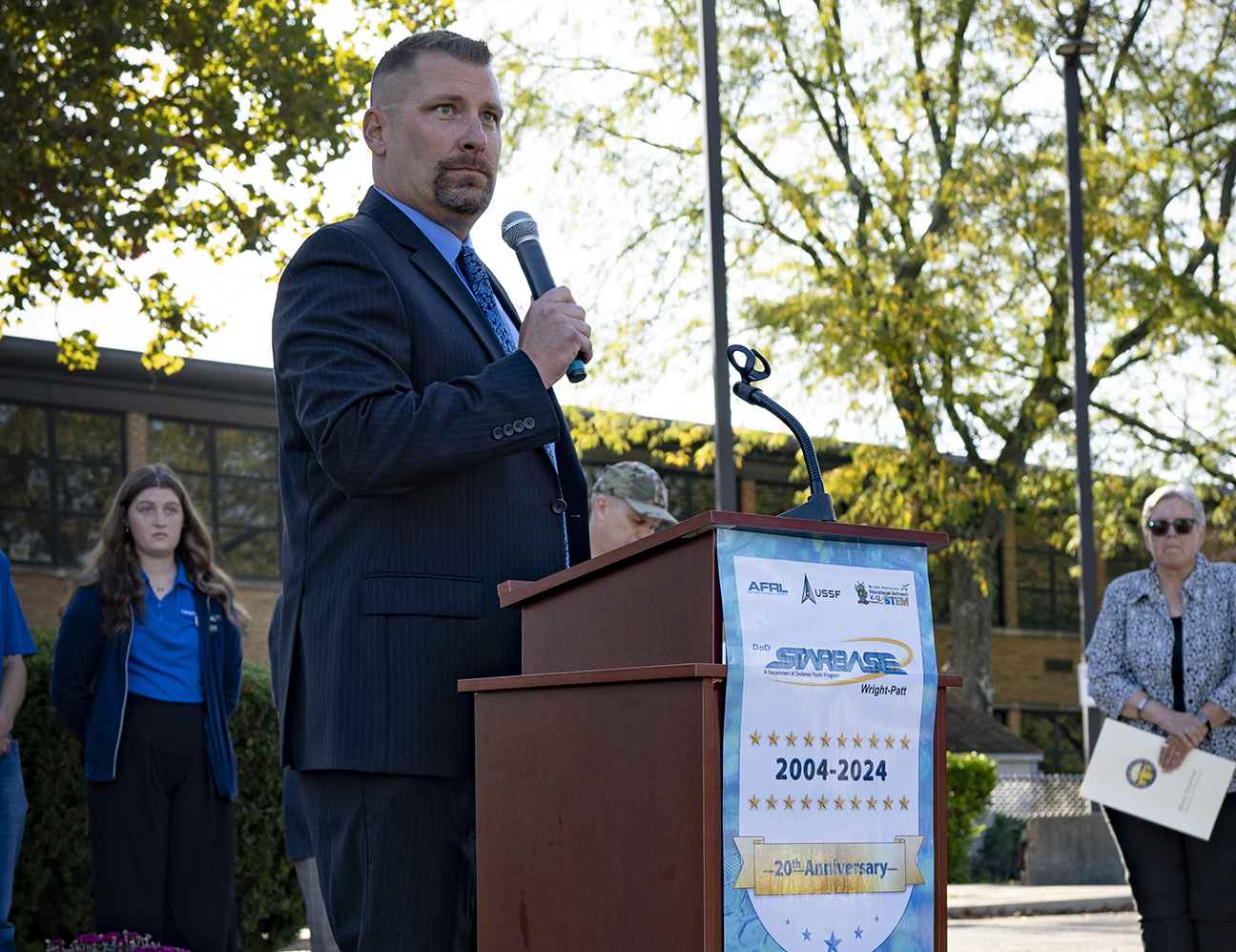
Dan Andrews, STEM division chief at the Air Force Research Laboratory, or AFRL, addresses attendees at the 20th anniversary celebration of the Department of Defense STARBASE Wright-Patt program Oct. 4, 2024, at a Child Development Center on Spinning Road in Dayton, Ohio. STARBASE Wright-Patt is a K-12 DOD science, technology, engineering and math outreach program managed by the Wright-Patterson Air Force Base Education Outreach Office and is primarily focused on fifth-grade students. Since 2003, more than 47,000 students have participated in the DOD Wright-Patt STARBASE program. (U.S. Air Force photo / Keith Lewis)
“I absolutely loved it,” she said. “Then when I started teaching … I realized we still brought our kids to STARBASE, and I was so excited.”
Tyson remained heavily involved with the STARBASE program until she chose to leave teaching but knew she wanted to remain in education, which led her to her current position on base.
“It’s so important to learn what STEM can do and where it can take you,” she said. “It’s not just science. It’s not just technology. You can do anything with it.”
“I don’t even know where I would be [without STARBASE],” she added.
As the U.S. economy grows increasingly dependent on workers with strong STEM skills, the number of available STEM jobs is also projected to increase rapidly, according to the proclamation. Programs like STARBASE are critical to ensure that a steady supply of skilled workers stands ready to meet economic demands.
“STARBASE itself is an incredible program. It helps to prepare the coming generations for the workforce, particularly in the growing field of STEM jobs,” Puff said. “The educators here are phenomenal, dedicated and passionate about their work. You watch the commitment, and you know they absolutely love what they’re doing.”
During a tour of the STARBASE building, Puff observed Bartolomei interacting with a classroom of children, all of whom had questions for the AFRL commander. In response to his request for at least three questions, every student’s hand was raised.
Puff said this is a testament to young people’s eagerness to learn and serve their communities and their country.
“Although they may not realize it, these students are learning how to be better citizens and servants,” Puff said. “STARBASE is a fantastic program that helps cultivate this mindset.”
Puff encouraged the children to continue to seek out mentors and learn from them.
“STEM is a rapidly growing field and there are many individuals willing to share their knowledge and skills,” she added.
In the military, particularly at Wright-Patterson Air Force Base and in the Ohio National Guard, there are leaders who are eager to answer questions and provide guidance, Puff said.
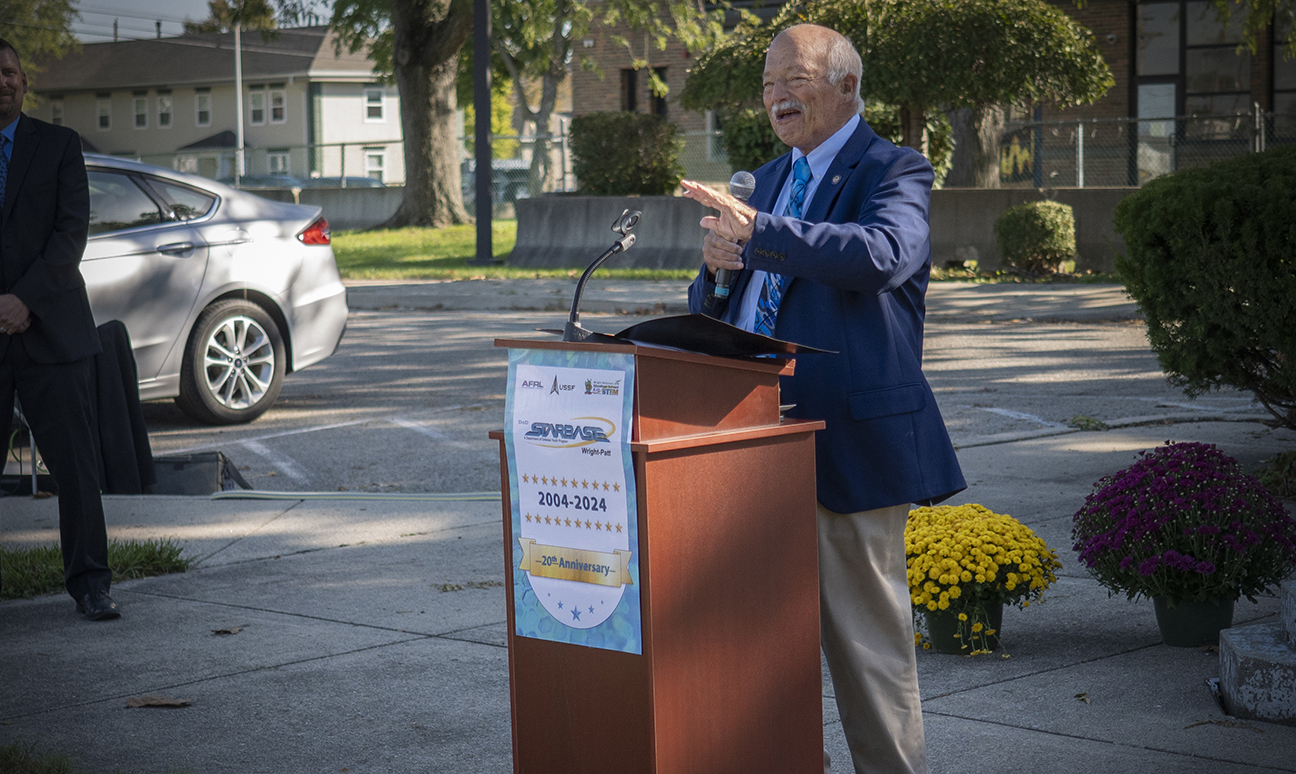
Ohio State Sen. Bob Hackett reads a proclamation from the Ohio Senate, signed by himself and Senate President Matt Huffman, as Air Force Research Laboratory, leaders and community members celebrate the 20th anniversary of the Department of Defense STARBASE Wright-Patt program Oct. 4, 2024, at a Child Development Center on Spinning Road in Dayton, Ohio. “Recognition of this memorable milestone is a fitting tribute to DOD STARBASE Wright-Patt, for since its inception it has played a valuable role in encouraging young people to explore [science, technology, engineering and math] as part of their future endeavors,” Hackett read from the proclamation. “We are certain that in the years to come it will continue to help students become capable and well-rounded individuals.” (U.S. Air Force photo / Keith Lewis)
While there are more than 90 STARBASE locations, Michael J. O’Toole, director, Civil-Military Programs, Office of the Assistant Secretary of Defense for Manpower and Reserve Affairs-Reserve Integration praised the DOD STARBASE Wright-Patt program as a model for STARBASE locations nationwide.
“For the last 20 Years, STARBASE Wright-Patt has been serving the greater Dayton, Ohio student population with exciting, hands-on, minds-on activities in partnership with our participating school districts to introduce STEM concepts and encourage youth to explore these courses of study and career fields as they get older,” O’Toole said. “I could not be prouder of our collective efforts and would like to thank our community partners and the United States Air Force in their continued support to this important youth outreach program.”
Bartolomei added that STARBASE is helping to break down barriers and open doors for all students, regardless of their backgrounds.
“I have no doubt that STARBASE will continue to inspire and empower generations of STEM leaders for many years to come,” Bartolomei said. “Let’s continue to do all we can to support it. Let’s ignite the future of STEM for another 20 years. Together, we will build a brighter tomorrow for our Air Force, Space Force and our nation.”
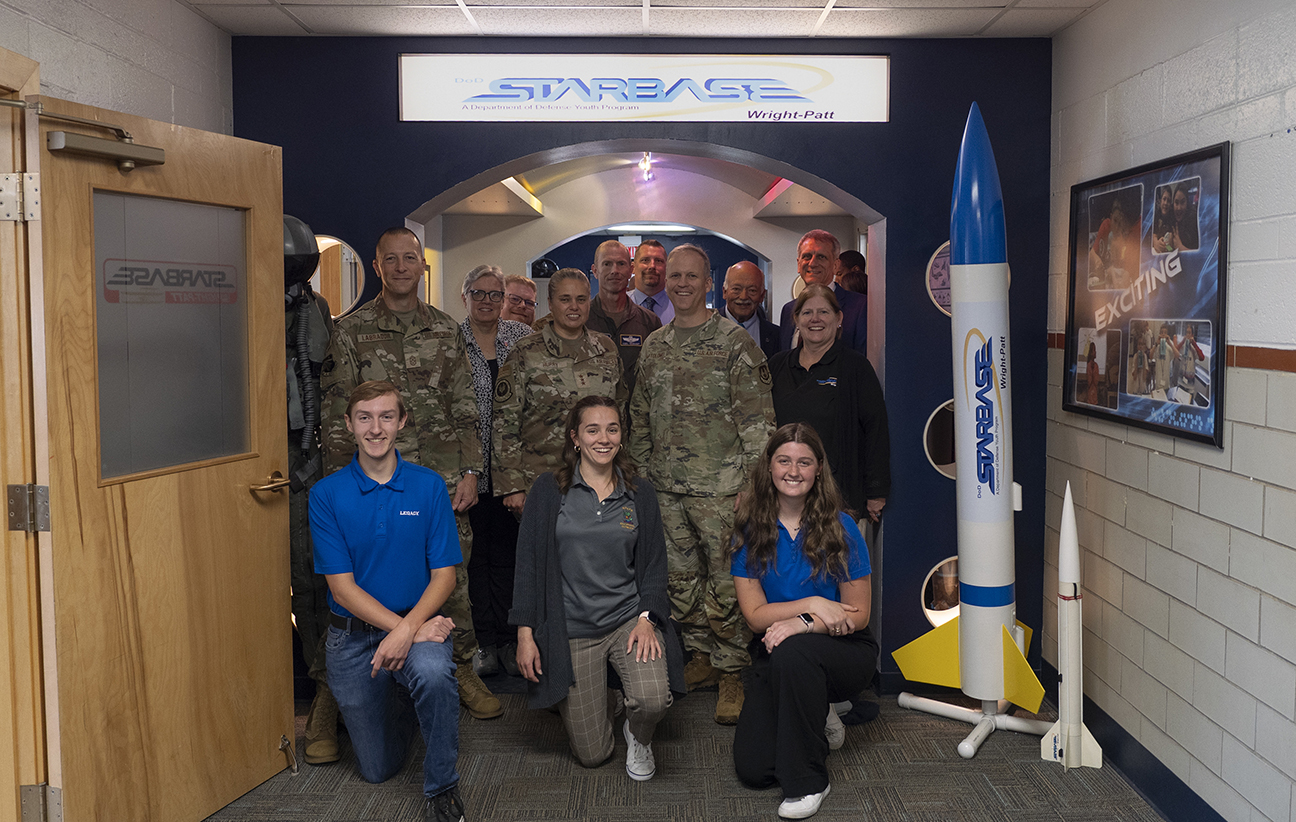
Air Force Research Laboratory leaders and community members pose for a group photo at the 20th anniversary celebration of the Department of Defense STARBASE Wright-Patt program Oct. 4, 2024, at a Child Development Center on Spinning Road in Dayton, Ohio. STARBASE Wright-Patt is a K-12 DOD science, technology, engineering and math outreach program managed by the Wright-Patterson Air Force Base Education Outreach Office that is primarily focused on fifth-grade students. Wright-Patterson Air Force Base was one of the first active-duty bases to launch a STARBASE program, and since 2003, more than 47,000 students have participated at Wright-Patt. (U.S. Air Force photo / Keith Lewis)
About AFRL
The Air Force Research Laboratory is the primary scientific research and development center for the Department of the Air Force. AFRL plays an integral role in leading the discovery, development, and integration of affordable warfighting technologies for our air, space and cyberspace force. With a workforce of more than 12,500 across nine technology areas and 40 other operations across the globe, AFRL provides a diverse portfolio of science and technology ranging from fundamental to advanced research and technology development. For more information, visit afresearchlab.com.
